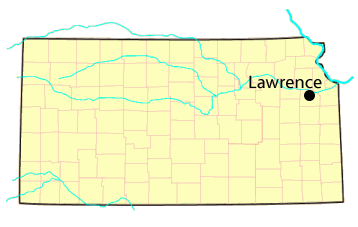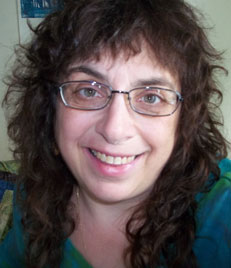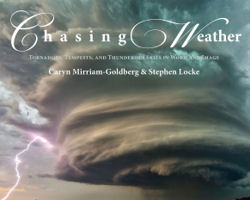
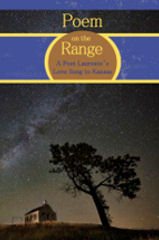
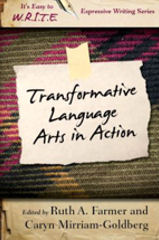

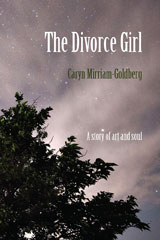
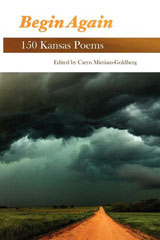
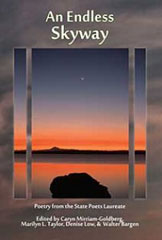
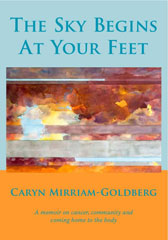
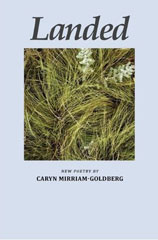
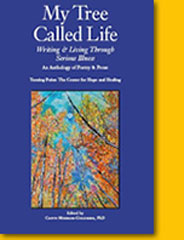
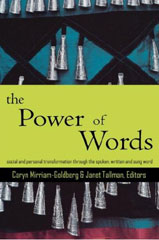
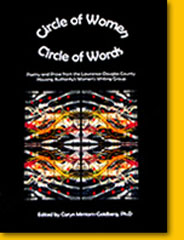

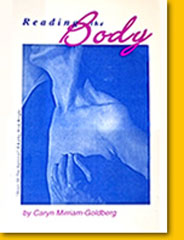
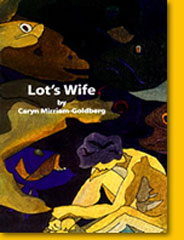
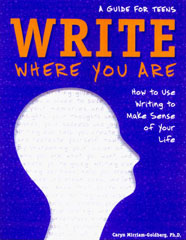
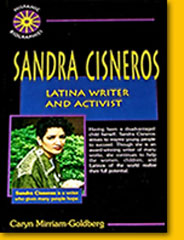
|
| Biography |
|
| |
Caryn Mirriam-Goldberg is the poet laureate of Kansas, serving from July 1, 2009 through June 30, 2012. Raised in Brooklyn, NY and Manalapan, NJ, she has lived in the Midwest since 1979 and in Kansas for 30 years, making her home with the writer Ken Lassman on a family farm just south of Lawrence, KS. Caryn is the author of over a dozen books, including four collections of poetry; The Sky Begins At Your Feet: A Memoir on Cancer, Community & Coming Home to the Body; a forthcoming novel; and several anthologies. Her poetry and prose has been published in over 50 journals and anthologies, and she has given hundreds of readings, talks and workshops in the U.S. and Mexico. Her writing often concerns how to live in balance with the earth and sky, and foster greater awareness and community.
Founder of Transformative Language Arts -- a master's program on using the written, spoken and sung word for social and personal transformation -- at Goddard College where she teaches, Caryn also leads community writing workshops widely for many populations, particularly for people living with serious illness, adults in transition, and on writing as it relates to mythology, ecology and community.
"Brave Voice," Caryn's business with singer Kelley Hunt, offers writing and singing retreats and collaborative performances and workshops. Caryn also co-writes songs with Kelley Hunt, and she is a registered songwriter with B.M.I. Her songs have been performed by Hunt and her band on "A Prairie Home Campanion," XM radio, and throughout the U.S. and Europe.
Return to Top of Page |
|
|
Bibliography ( - housed in Thomas Fox Averill Kansas Studies Collection) - housed in Thomas Fox Averill Kansas Studies Collection) |
|
| |
 Following the Curve (Spartan Press, 2017) Following the Curve (Spartan Press, 2017)- Chasing Weather: Tornadoes, Tempests, and Thunderous Skies in Word and Image (Ice Cube Press, LLC, 2014)
 Poems on the Range (Coal City Press, 2014) Poems on the Range (Coal City Press, 2014)
- Transformative Language Arts in Action (Rowman & Littlefield Publishers, 2014)
 Needle in the Bone: How a Holocaust Survivor and Polish Resistance Fighter Beat the Odds and Found Each Other (University of Nebraska Press, 2012) Needle in the Bone: How a Holocaust Survivor and Polish Resistance Fighter Beat the Odds and Found Each Other (University of Nebraska Press, 2012)
 The Divorce Girl (Ice Cube Books, 2012) The Divorce Girl (Ice Cube Books, 2012)  To the Stars Through Difficulties: A Kansas Renga in 150 Voices (Mammoth Press, 2012) To the Stars Through Difficulties: A Kansas Renga in 150 Voices (Mammoth Press, 2012)
 Begin Again: 150 Kansas Poems (Woodley Memorial Press, 2011) Begin Again: 150 Kansas Poems (Woodley Memorial Press, 2011)
- An Endless Skyway: Poetry from the State Poets Laureate (co-editor with Marilyn L. Taylor, Denise Low and Walter Bargen, Ice Cube Books, 2011)
 The Sky Begins At Your Feet: A Memoir on Cancer, Community & Coming Home to the Body (Ice Cube Books, 2009) The Sky Begins At Your Feet: A Memoir on Cancer, Community & Coming Home to the Body (Ice Cube Books, 2009)
 Landed (Poetry, Mammoth Publications, 2009) Landed (Poetry, Mammoth Publications, 2009)
- My Tree Called Life: Writing & Living Through Serious Illness (Turning Point Press in partnership with Mammoth Publications, 2009)
- The Power of Words: A Transformative Language Arts Reader (co-edited with Janet Tallman, TLA Press, 2007)
- A Circle of Women, A Circle of Words: Writing from the Lawrence-Douglas County Housing Authority (Lawrence-Douglas County Housing Authority in partnership with Mammoth Publications, 2004)
- Animals in the House (Woodley Press, 2004)
Reading the Body (Mammoth Publications, 2004)
 Lot's Wife (Woodley Press, 2000) Lot's Wife (Woodley Press, 2000)
- Write Where You Are: How To Use Writing to Make Sense of Your Life (Free Spirit Press, 1999)
- Sandra Cisneros: Writer and Activist (Enslow Press, 1998)
Return to Top of Page
|
|
|
| Writing Samples |
|
| |
from Story, collaborative book in process with photographer Stephen Locke
After the Storm, the Stars
rise from the Osage Orange, wheeling effortlessly overhead as if
nothing has changed. They shine awake in the fresh open heart of the air,
cleansed free of all but the wind without end that lashes leaves against leaves.
Meanwhile, the rays of remnant clouds burn translucent, then invisible.
The exposed dirt ages in the wind. A slat from a child's doll cradle grows into
the grass. Paper from two towns away lifts to ferry important words nowhere.
The sky exhales, waits, surges then drops to the disturbed ridge where flowers
rock upside, the rocks from elsewhere dream of the old days, and in the off and on
cadence of distant train whistles someone's cries come staccaco to this night
wrapped in shimmer and quiet. Tomorrow, not so far from here, there will be
search dogs and careful lifting of sheetrock and broken furniture, then
bulldozers and power saws, rented U-hauls to save, then clear, whatever is left.
Months ahead to measure what was lost, articulate what the weather can do
in numbers and even more, read the brail of the stories left behind. The new world
not conjured arrives here anyway, and over this sprawling tree of life, the stars.
(Note: published in smaller font to reflect the line breaks where the poet intended)
Celebrate This Kansas
Celebrate this sky, this land beyond the measured time
that tilts the seasonal light. Dream the return of the stars,
the searing rise of heat or fall of storm crossing through
the secret-holding cedars and witness rocks for thousands of years.
This air we breathe belonged to those who spoke languages forgotten
as the glaciers cusping the ridges. These fields we walk once rushed
in ocean long after, long before what we know as mapped time.
This rain was once a man's last breath, this heat what warmed
a weathered rock enough for a woman to rest on with her baby,
these fossils once love songs of memory and longing after the beloveds die.
Everything we know of Kansas comes from this: rivers aching east
after scouting out and winding their mark through the horizons of grass,
skies mirroring orange to black, moon to sun, hail to pale breeze,
ready to give everything to us like any true heart.
All we see, the ghost and angel of the land's lightest touch,
a trail through the prairie, a hard rain in the woods -- beyond naming
and yet named Step into where you already are, where once
the grandmothers and grandfathers sang out their stories of
weather and loss, wars and births. The bones of this land and the feathers
of this sky compose this Kansas that knows us better than we know ourselves,
that is always ready with wind, shimmer, falling grasses and stone roots
to show us what it means to live where the earth and stars converge.
-- Caryn Mirriam-Goldberg, written for the Kansas Sesquicentennial Celebration, 1/29/11
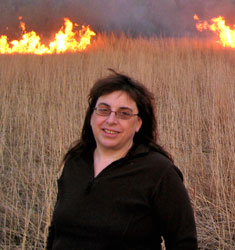
Writing From The Earth: An Essay on Place, Poetry & Prose
I write in the field, sitting in my house in the center of a west-sloping circle of half-brome, half-native prairie surrounded by hills of forest. Sometimes I sit in the grass and write in the wind. Sometimes I huddle behind my desk staring at the ten or more shades of tan that create winter in the distance. But it is always the field that surrounds me, that I remember when I'm apart from it, the field that teaches me most about how to write.
In the field, I hear the rhythms that climb and run, fall and sleep through and around me. In the field, I let go of finding the words enough to find the words. Over and over, I have the sense that everything I need to know about poetry is right here. Just listen. Just stop.
My writing comes from this stopping, this listening. My poetics is best described by poet Li-Young Lee who, in a recent interview, said: "The whole Universe if humming, is vibrating. It's that hum that I want to hear. That's the subject of my poems....The words are like birds that perch on this frequency of sound."... [read entire essay]
Return to Top of Page
|
|
|
Author Interview |
|
| |
Q: What inspired you to begin writing?
A: As soon as I could hold a crayon, I was drawing, and I grew up
passionately (obsessively?) drawing, painting and doing other visual
arts, but when I was 14, two things happened that led me abruptly to
writing. One was that I was watching a friend in art class spend hours
on a pen and ink drawing. When he told he had spent six hours on a 2
inch by 2 inch square of it, I immediately thought, "Oh, being an
artist means being patient, and since I'm not patient, I can't be an
artist." Stupid thinking on my part, but I was 14, a time when
hormonal changes turn logic inside-out. The bigger thing that happened
was my parents' traumatic and dramatic divorce (aka The War of the
Roses), which lasted a long, hard time. I survived both my parents
living in the same house, barricaded apart from each other, by
writing, and I quickly funneled all my art-making energy into poetry.
I also found a spectacular mentor -- an English teacher named Judith
Rance-Roney (who I'm still in touch with today). Although she thought
something was seriously wrong with me when we were reading Beowulf,
and I couldn't comprehend anything, she quickly changed her mind when
she saw my poetry, and she invited me to show her a poem a day, an
invitation that helped save my life at the time and gave me the
confidence to keep writing. She also sent me to lots of great poets to
show me the possibilities of poetry. She was a young teacher, just out
of college, not much older than me, and she was an amazing mentor and
guide for me when I most needed one.
Q: Is poetry your first love?
A: Well, poetry is like my first husband, but I would say I dated visual
arts and also music for years first (and still do on occasion). Some
of us are born hard-wired to make things, and I'm one of those people.
I have to draw, collage, write, play piano, sew, crochet, etc. or I go
out of my mind. Yet I always knew I would write fiction -- it had
called to me for decades, and I had a sense I would start when I was
30 or so, and I did. I began my first novel 17 years ago, and I have
a second novel almost finished and ready to send out into the world. I
also write memoir, blog posts (a form that feels created just for me
-- I love to write short vignettes of life), songs with singer Kelley
Hunt and other songwriters, and essays. I love all these genres and
have co-habitated with many of them for many years.
Q: What was it that drew you to Kansas?
A: First, I was drawn to Kansas to run a grassroots campaign on energy
conversation and oil regulation way back in 1982, but here's the story
behind that story: I lived in Kansas City (from 1981-83), after going
to school at MU. I ended up at MU because as a poet, I thought I was
supposed to study something like journalism, and MU had a good
journalism (by reputation, at least) at the time. But I ended up
seriously feeling out of place in journalism school -- a place that
tends to draw the most cynical (and here I was writing love poems to
trees) and ended up with a history degree. Go figure! After MU, I
moved to Kansas City to work for a labor newspaper, got fired in a sex
discrimination deal, went to the Missouri Commission on Human Rights
to file a complaint, and got a job there instead. I left that job to
do grassroots organizing for some years, and thus, Kansas. What drew
me to live in Kansas was my husband, Ken Lassman, who I met in '82,
and here we are many years later on land where he's 5th generation
just south of Lawrence.
Q: Have any Kansas authors inspired you?
A: Absolutely. William Stafford was and still is my secret teacher,
helping me learn how to write and live. I love his books of prose and
interviews as much as his poetry, and especially these sayings of his:
"Treat reality as if it really existed" and "Language can do what it
can't say." I also love the poetry of Denise Low, Patricia Traxler,
Steven Hind, Judy Roitman, Bill Sheldon, Ramona McCallum, and many other contemporary poets.
Q: How did the idea for the Transformative Language Arts program come about?
A: I had been teaching at Goddard College part-time and also doing
writing workshops for many populations for many years when it occurred
to me that if I did nothing but teach community writing workshops, I
could make a living. I figured that if I could do this in Kansas,
people could do it all over. I also realized how important these
workshops were to the participants: how writing in community helped
people hear their own thoughts and get into rhythm with the pulse of
their own lives. The transformative power of writing, storytelling,
performance and other word-related arts was and is so central to our
lives, and yet there's few ways to study this in depth in most college
programs. So I developed TLA, drawing from the wisdom of colleagues,
students, people in the field, and it's been going ever since. We have
the program at Goddard and also the TLA Network, which offers on-line
classes, a conference, writing projects and more. I love seeing how
much this emerging field, profession and calling resonates with people.
Q: How do you go about writing a song? Do you write the lyrics and Kelley Hunt the tune, or do you each do both?
A: Kelley and I tend to work on all the above together, calling out
words, humming tunes or suggesting musical sounds, and writing in a
way that it's almost impossible to say who does what. While I tend to
write more of the words and she tends to write most of the music (and
certainly arranges it all), we work in a truly ecstatic collaboration.
Sometimes, we're part-way through one song when one of us calls out,
"Incoming!" and writes furiously lines for another song that comes.
It's a wild joy to do this work with her.
Return to Top of Page
|
|
|
| Links |
|
| |
Links to Writing Prompts
15 Writing Prompts: Writing from your life, September & October
Writing not the way we think
Invoking the visible
Other Links
Caryn's Website
Caryn writes a daily blog, "Everyday Magic"
For more on Transformative Language Arts, please see Goddard College's program and the non-profit Transformative Language Arts Network.
Read Caryn's essay, "The Imaginary Friend of the Page"
Learn about state poets laureate and various events organized here in Kansas with Midwestern and National convergences of state poets laureate.
Explore 150 Kansas poems through To the Stars Through Difficulty a
150-voice renga (a conversational poem for which each poet adds
another 10 lines)that will be published later this year by Mammoth Press (Lawrence, KS). These projects, part of the poet laureate program (that I now carry in my pocket due to the diminishment of our state arts
commission) have led to 19 readings across the state so far and more
coming over the next year, all featuring the "poetry caravan,"
basically whoever of the dozens and dozens of poets involved who is
able to jump in a car and travel with us to all corners of Kansas.
See Caryn's Wikipedia page.
Read about Caryn's poet laureate projects, vision and work, FAQ , and her report to the people of Kansas on the 2010-11 fiscal year. (Note: because of the defunding of the Kansas Arts Commission, the poet laureate pages are temporarily residing at Caryn's website, and will soon to be moved to another organization's site.)
More on Caryn's biography and venues where she's presented.
Articles, reviews in-print, and audio interviews from publications and radio stations with Caryn.
Return to Top of Page |
|
|
|

